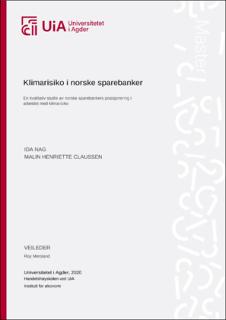| dc.description.abstract | Increased climate change over the last century has led to efforts towards a low-emission society. Such a transition can entail risks, which in turn can affect the financial stability of the Norwegian economy, including Norwegian savings banks. Based on the main goals of the Paris Agreement, Norway presented revised climate targets, where the goal was to reduce the 1990-emission levels with 50-55 percent. This makes the transition to a low-emission society more immediate than first expected. As Mark Carney, the Governor of the Bank of England pointed out, the climate crisis may be the new financial crisis. Therefore, it is important that Norwegian savings banks include climate risk, along with other risk factors in banks.The purpose of this study was to explore the status of Norwegian savings banks, according to the work of including climate risks in their credit processes. To answer this research question, we have applied theory and literature related to the definition of climate risk, corporate social responsibility, sustainability and financial risk, as well as resource-based view. The data collection was based on a combination of different methods, respectively a quantitative content analysis of annual reports from all Norwegian savings banks from 2017-2019, as well as personal interviews of six respondents,from three large and three smaller savings banks.The results from the quantitative content analysis revealed an increased focus on climate risk, especially for the larger savings banks. The personal interviews revealed a significant difference in regard to understanding the concept of climate risk among the savings banks. Several of the banks seemed to interpret climate risk as corporate social responsibility or sustainability, rather than financial risk. Another important finding was the challenge related to lack of data and measurement tools. Further, we discovered that the biggest incentive related to the inclusion of climate risk for the savings banks,was the banks'positioning with regard to expected regulatory requirements from the authorities.In this study, we conclude that the large savings banks seems more familiar than the smaller savings banks, in their efforts to include climate risk as part of their processes. Common to all banks, is that they still seem to have challenges to fully implement climate risk. In order to increase the number of savings banks implementing climate risk, we recommended regulators to introduce explicit law requirements, as well as developing good measuring tools. In general, we concluded that there is a great need for more expertise related to climate risk. | en_US |

